Assembly Areas [4.33]
ADAAG requirements for assembly areas apply to areas where groups of people gather for recreational, educational, political, social, or amusement purposes or for the consumption of food and drink. Areas used for other purposes are not covered by 4.33, including those that may be considered assembly occupancies under building codes. For example, restaurants and cafeterias are additionally covered by section 5 although certain requirements in 4.33 may apply to dining facilities equipped with performing areas, fixed theater-style seating, or audio-amplification systems for entertainment purposes.
Scoping [4.1.3(19)]
Requirements for accessible seating and permanent assistive listening systems apply where seating is fixed or built-in. This includes seating that is permanently or temporarily fastened to the structure, or that is retractable, such as some bleachers. Requirements for portable assistive listening systems (outlets and wiring) may apply to areas without fixed seating.
Accessible Seating
The minimum number of wheelchair spaces applies to individual spaces (33 inches wide minimum). Those that are paired (as shown in ADAAG Figure 46) count as two spaces. At least one fixed seat for a companion must be located next to each wheelchair space. Aisle seats with folding or removable armrests (or no armrests) are required for people who walk with difficulty or who prefer to transfer from wheelchairs.
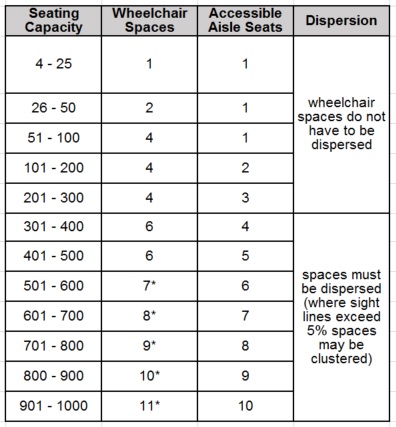
*over 500, 6 plus 1 for every seating capacity increase of 100.
Wheelchair Spaces
Maneuvering into wheelchair spaces is often easier from the front or back than from the side, especially where they are paired. Paired spaces allow flexibility for people attending a performance together. Wheelchair spaces should not overlap required exit widths or circulation paths and should provide for shoulder-to-shoulder alignment with occupants of adjacent seats (an important consideration in calculating sight lines). The 33-inch minimum width for spaces provides extra width for maneuvering within a confined area.
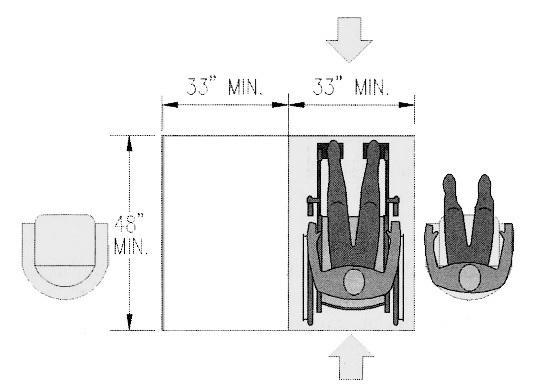
Wheelchair spaces must be level (2% maximum slope in any direction) and adjoining routes and maneuvering spaces must provide flush connections so that maneuvering to and from spaces does not occur on a slope. Spaces with side approaches are required to be longer (60 inches minimum) to provide maneuvering for turns into the space.
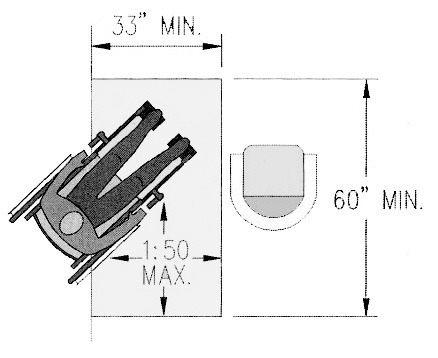
Companion Seating
At least one fixed seat is required next to each wheelchair space. Pairing wheelchair spaces allows two people who use wheelchairs to sit together.

Removable seats or other fixed seats that swing or fold away from the space can be used in wheelchair spaces. Folding seats are more convenient and require less planning than seats that must be removed in advance by facility management. Some paired folding seats fold into a fixed center bar to allow one or two wheelchair spaces. However, the minimum number of wheelchair spaces plus their companion seats still must be provided.
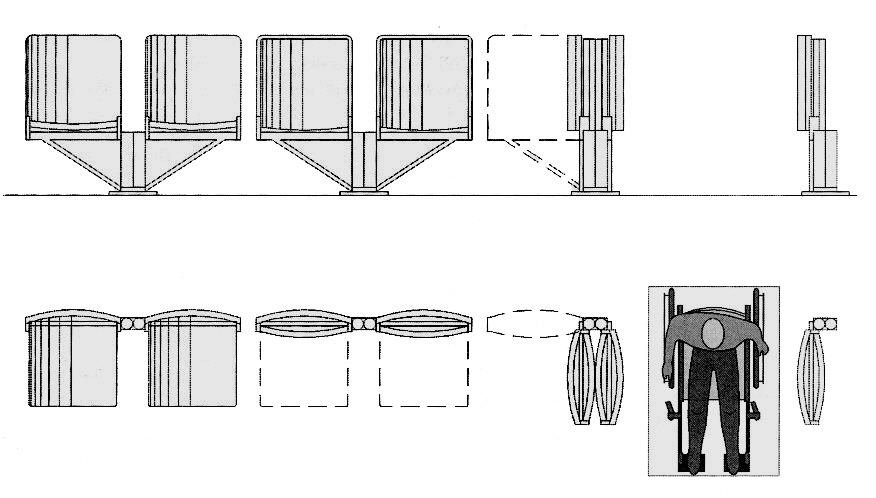
Dispersion
People with disabilities must have comparable sight lines (and choices of admission prices) as do other members of the general public. Dispersion is required where fixed assembly seating exceeds 300. Wheelchair spaces must be provided in all areas, including sky boxes and specialty areas. Even in small facilities where few spaces are required, offering choice in seating and viewing distance should be a design objective. This includes choice in both vertical and horizontal sections of a seating bowl and may vary by event. Accessible seating should be located to maximize flexibility in multi-purpose facilities. Clustering wheelchair spaces is allowed only where sight line slopes exceed 5%, such as bleachers and balconies (or in alterations where dispersion is technically infeasible). This exception is intended to apply only to those discrete parts of an assembly seating area where aisles are sloped or stepped and where the pitch of the line of sight is greater than 5%. Often such seating is situated high above the performing area. This is not an exemption from requirements for integrated or companion seating or choice in admission prices. Where dispersion is feasible, it must be achieved.
Integration
Integrated settings are an important principle of access. Even where wheelchair spaces are not required to be dispersed, it is important that they be provided within the footprint of the seating layout. (Bleachers with notches or cut-out areas will provide both integration and companion seating.) Where wheelchair seating areas are located next to busy circulation areas, barriers may be advisable to prevent crowd overflow. It is important that such separations not obstruct or complicate maneuvering to and from seating areas.
Sight Lines
Both the horizontal and vertical viewing angles must be considered in the design of assembly areas. A variety of factors determine the quality of "vertical" sight lines, such as the distance from performance areas, row spacing, staggering of seats, and floor slope. Sight lines are calculated according to certain industry conventions and practices. Some conventions, such as the average eye level height of a seated adult is within the accepted range for people seated in wheelchairs. Industry conventions for determining lines of sight may be adequate for facilities where the audience is not likely to stand during events or performances. However, sports arenas and other facilities where spectators may stand during events add a critical dimension to achieving lines of sight from wheelchair spaces. When only conventional seated sight lines have been used to determine the seating bowl shape, standing spectators usually obstruct the line of sight for several rows in front of a person using a wheelchair who cannot stand with the rest of the audience. In such facilities, wheelchair spaces must provide lines of sight over standing spectators. This can be accomplished by increasing the elevation of wheelchair seating or, in some cases, locating wheelchair seating at cross aisles.
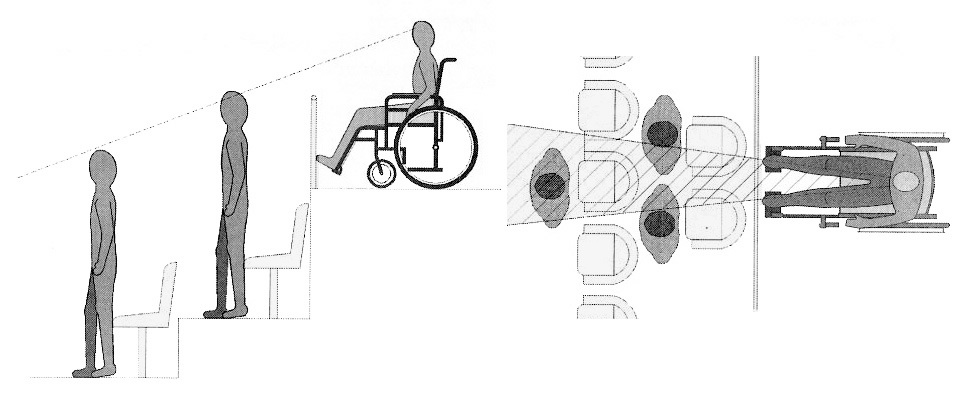
Emergency Egress
ADAAG requires that accessible seating be located on an accessible route which also serves as a means of egress. Recommendations: Considerations beyond this basic requirement may be advisable in large assembly areas since they usually have several required exits. According to research sponsored by the Access Board ("Access to Assembly Areas" by the Center for Accessible Design, 1992), it may be prudent to provide more than once accessible means of egress route from accessible seating. Consider:
-
more than one accessible means of egress from accessible seating to accessible exits or areas of rescue assistance
-
locating wheelchair spaces to minimize the distance to accessible exits or areas of rescue assistance
-
accessible egress routes that coincide with other exit routes to avoid forcing a person using a wheelchair to travel against the general flow
-
increased aisle widths along accessible egress routes to allow passing and easier maneuvering
Building or life safety codes specify the minimum distances between rows of fixed seating in consideration of the number of seats per row, exit aisle widths, and the arrangement and location of exit doors. Recommendations: "Continental" seating can facilitate access to and from mid-row seats for all people, including those who walk with difficulty since row spacing and exit door requirements are increased in order to achieve a greater number of seats per row. Wider row spacing and aisle widths can accommodate wheelchair seating so that unobstructed required exit widths are maintained.
Access to Performing Areas [4.33.5]
An accessible route must connect wheelchair spaces with performing areas, including stages, arena floors, playing fields, dressing and locker rooms, dugouts, and other areas used by performers or players. Recommendations: Accessible routes should coincide with the general route; alternate back-of-the-house routes, while not specifically prohibited by ADAAG, may nonetheless be considered discriminatory. Aisles with slopes no steeper than 1:12 are often feasible in small and medium size assembly areas and permit accessible routes that coincide with general routes. While handrails are not required on ramps adjacent to assembly seating, locating aisles (including those that are stepped) along walls will permit handrails on one side for the benefit of people who walk with difficulty.
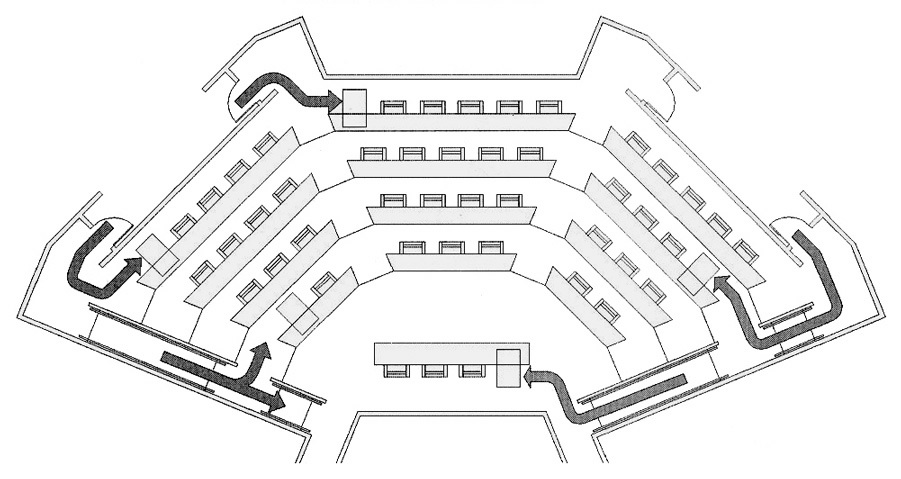
Assistive Listening Systems (ALS)
Assistive listening systems pick up sound at or close to its source and deliver it to the listener's ear. This more direct transmission improves sound quality by reducing the effects of background noise and reverberation and, as needed, increasing the volume. These devices serve people who are hard of hearing, including those who use hearing aids. Personal systems are available for use in a variety of situations, including individual conversations. ADAAG covers those systems used with public address systems in certain assembly occupancies.
How ALSs Operate
Like public address systems, ALSs convert live or recorded sound into an electromagnetic signal. A sound source (usually a microphone) sends the signal to a transmitter which relays it to receivers provided to listeners. Couplers, such as ear phones, decode the signal from the receiver and convert it back into sound for the user. Recommendation: While a "complete" system with the necessary components can be bought off-the-shelf, ALSs designed as "mix and match" systems can provide a range of components appropriate for individual users, events, and environments.
Types of Systems
Assistive listening systems are generally categorized by their mode of transmission. There are hard-wired systems and three types of wireless systems: induction loop, infrared, and Fh4 radio transmission. Each has different advantages and disadvantages that can help determine which system is best for a given application. For example, an FM system may be better than an infrared system in some open-air assemblies since infrared signals can be overpowered by the sun; on the other hand an infrared system is typically a better choice than an FM system where confidential transmission is important. Recommendations: In selecting an ALS, consultation with professionals such as sound system consultants or contractors is often a good idea. No matter which technology is used, consider too that the quality of the system often determines the quality of the sound and transmission.
Minimum Requirement
ADAAG requires permanently installed ALSs in those assembly areas where audible communication is integral to the use of a space (movie theaters, concert and lecture halls, playhouses, meeting rooms, etc.); where fixed seating is provided and where there may be an audio-amplification system. For other assembly areas, such as those without fixed seating, ADAAG requires either a permanently installed system or electrical outlets and supplementary wiring for a portable system; this requirement, however, does not necessarily require the addition of electrical outlets.
Assembly Areas
(where audible communication is integral to use of the space)
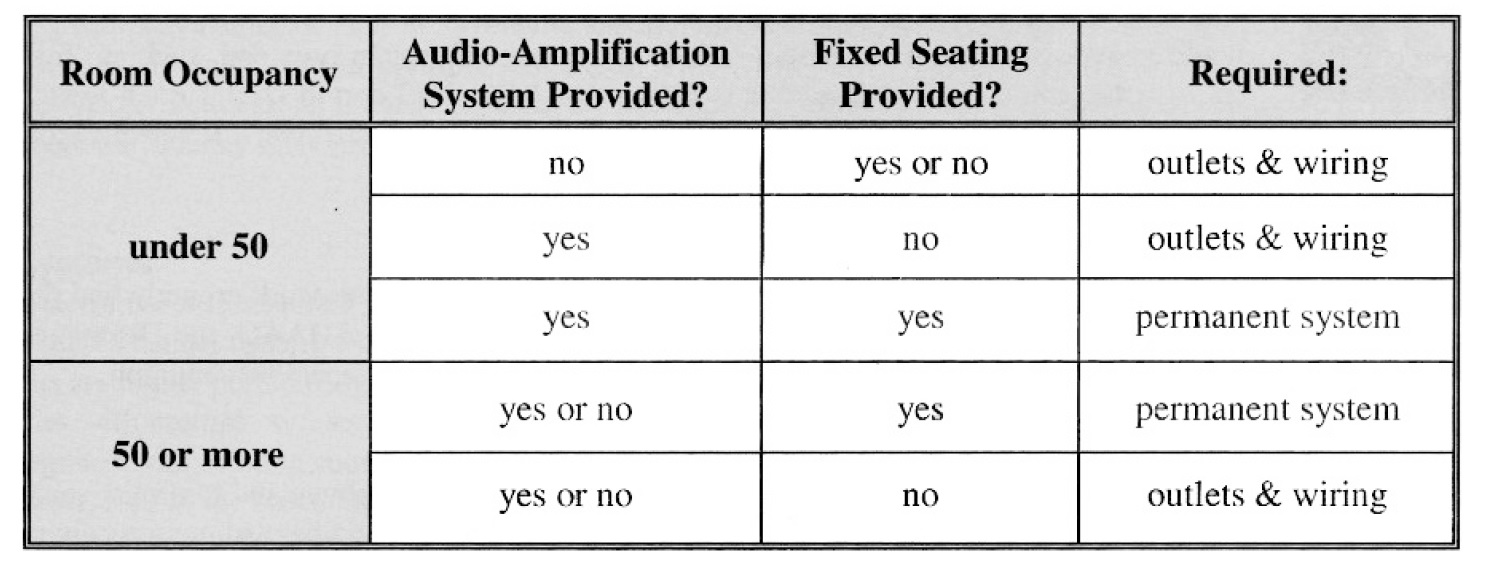
Public Address Systems and Microphones
ALSs can be integrated with public address systems or operated separately. Recommendations: Both systems can share sound sources (microphones, mixers, tape players, VCRs) but not all microphones of a public address system work well with ALSs. Also, it is highly recommended that the ALS signal processor and amplifier be separate from the public address system unit in order to maintain independent equalization and volume control and to prevent distortion and feedback. No matter what system is used, selection of microphones is critical. For achieving the best sound quality, microphones (including wireless and lavaliere) should:
-
limit background noise (noise-suppressing directional types, such as those with cardioid or hyper-cardioid patterns are best)
-
provide the highest gain signal (consider battery-powered or "phantom" powered condenser microphones)
-
accommodate speech over all frequencies (use wide frequency response microphones and avoid foam wind screens since they can filter out high frequencies)
-
be used with an automatic mixer (which activates microphones as they are spoken into) where multiple microphones are used
For best results, participants should be sure to use microphones and speak one at a time, talk close to microphones "across" the top (which improves transmission of consonant sounds), and use their regular volume level, allowing the system to do the work.
Receivers and Couplers
ADAAG requires that receivers be provided to serve at least 4% of the total number of seats (but in no case fewer than two). Couplers connect the ALS receiver to the listener's ear. Recommendations: While a system may come with only one type of receiver, a variety helps meet the needs and preferences of different users. People often choose to wear their hearing aids while using assistive listening systems. It is important that couplers or receivers be compatible with hearing aids. Neckloops and headsets that can be worn as neckloops will be compatible. Receivers that arc not compatible include earbuds, which may require removal of hearing aids, silhouette transducers, earphones, and headsets that must be worn over the ear, which can create disruptive interference in the transmission.
Signage
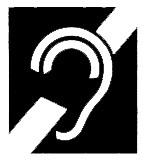
Maintenance
By far, the most frequent complaint about assistive listening systems is that they do not work properly and that no one at a facility knows how to operate or fix them. While this is not addressed by ADAAG, the Department of Justice's title III rule requires that accessible features and equipment be maintained in operable condition.
Audio Induction Loop
This system uses a wire loop to receive input from a public address system or microphone and transmits sound by creating a magnetic field within the loop. Listeners must be sitting within the loop and have either a receiver or a hearing aid with a telecoil. Receivers can be connected to a variety of coupler types and are compatible with all loop systems. Loop systems are readily integrated with conventional sound systems and relatively easy to maintain. The loop may surround all or part of a room and can be permanently installed in the ceiling, floor or walls of a room. Portable systems are also available.
Since the signal created is, in a sense, electromagnetic interference, multiple loop systems can easily interfere with each other and are susceptible to interference from electrical wiring, computer monitors, transformers, and unshielded fluorescent lighting. In addition, the loop can also cause hum in electrical devices not shielded from electromagnetic fields, like a nearby cassette tape player. Also, construction steel in a building may cause erratic coverage (steel can absorb the magnetic fields, causing fluctuating reception). There is a new technology known as a 3-D mat that can be used instead of the conventional induction loop. There is very little spillover with 3-D mats and they are less susceptible to electromagnetic interference.
Consistent and uniform coverage is sometimes difficult with wire loops (although not with 3-D mats), depending on the application and the relative position of the listener. A listener's seating position and shifting can influence reception, making it better or worse. Moving the receiver position just a few inches can sometimes correct the reception.
Infrared Systems
These systems use invisible (infrared) light beams to carry information from a transmitter connected to a public address system or microphone to special portable receivers worn by the listener. The receiver is connected by wire to any of a variety of couplers or directly to a hearing aid equipped with direct audio input. A receiver and a coupler must be supplied to each listener, including those using hearing aids.
Infrared light, like visible light, does not penetrate most construction materials but can reflect off many materials and is broad beamed. An uninterrupted line of sight is required between the transmitter and the receiver. The configuration of rooms and architectural elements such as columns or decorative pillars are important factors in selecting and designing an infrared system. The overall strength of the incident light on the receiver will determine whether or not a usable signal can be received. Emitters must be installed high up on the walls and more emitters may be added and located as necessary to insure proper signal strength. Since the signal is overpowered by the sun, infrared systems may not be suitable in some outdoor areas that are unshaded, uncovered, or exposed to much sunlight. Incandescent and fluorescent lighting can also produce interference. One reported problem, not well documented, is possible interference from other devices using signals, such as audiovisual controllers for slide or VCR presentations.
An infrared system is the only wireless system that provides confidential transmission since the signal cannot go through non-transparent materials. There is no spillover to nearby systems and all transmitters and receivers in a facility can be tuned alike, an important consideration where multiple systems are provided in a facility. A person can walk from room to room, as in a conference, and not need a new receiver, or need to adjust a receiver for each room. Multiple channel systems are available and can be used to support descriptive video for people who are blind or simultaneous translation in multiple languages. Two channels are typically available by modulating the wavelength. (ALSs broadcast an infrared signal at a wavelength of 950 nm.) Infrared systems are reported to have somewhat better frequency response than FM systems.
FM Systems
FM systems use a short-range radio transmitter which converts sound to a radio signal sent to small FM radios tuned to the same channel usually worn around the neck. The radio receiver can be connected to a choice of couplers. FM systems are highly portable and flexible, subject to requirements for frequency control, and provide an alternative for facilities with multiple venues which can provide the requisite support. An FM system is simple to install and easily integrated with existing sound systems. There are few constraints on transmitter location since FM broadcasts are not constrained to the line of sight like infrared systems. Signal range is usually determined by the size of the antenna and the power of the transmitter but in most cases only one transmitter is needed (typical ALS range is roughly 300 feet). This, plus the fact that sunlight does not interfere with the signal, make it the best choice for large outdoor assemblies such as open-air arenas.
Each listener using the system must have an FM receiver but can move around more freely than with other wireless systems (loop, infrared). A choice must be made between providing fixed channel receivers (usable only with a compatible transmitter) and tunable receivers (more flexible, but also more expensive). Some people with hearing impairments have difficulty tuning a receiver, especially when multiple programs are being conducted.
The fact that FM signals can spillover into adjacent rooms or buildings can present problems. If confidentiality is required then an FM system is likely not the best choice. Use of an FM broadcast might also raise copyright issues for certain performances since anyone with a properly tuned FM receiver can intercept the broadcast. Some FM systems may experience signal drift (depending on the quality of the system), radio wave interference (depending on the environment), and interference from other FM devices using adjacent channels, such as pagers. Frequency management is an important consideration. However, most institutions that support multiple broadcasts are likely to have an audiovisual support staff which can assume responsibilities for this important task. The use of tunable receivers simplifies the problem of frequency control, but puts the responsibility on the listener. Implementation plans should include instructions and tuning assistance for users available where receivers and couplers are issued.
Multiple frequencies are possible and can support various programs such as audio description for people who are blind and simultaneous translation in multiple languages. However, a separate transmitter is needed when simultaneous programs are conducted within a facility, or even in nearby facilities.
Three formats are available within the frequency range (72 - 76 mHz) for ALS applications:
-
40 channels for the educational band (used in educational settings, this allows many simultaneous classes or events)
-
10 channels for wide band transmissions (popular in single channel applications)
-
17 channels for narrow band transmissions (useful where multiple FM systems are used in close proximity, such as a theater complex)
Hardwired Systems
Hardwired systems incorporate a direct wire link between the sound source and the coupler. Although the quality of the transmitted sound may be good, the fact that individual seats must be connected is so limiting that hard-wired systems are rarely used any more.
| INDUCTION LOOP | INFRARED | FM | |
| Sources of Signal Interference | wiring, computers, transformers, florescent lighting (less with 3-D mat); construction steel can cause erratic coverage | sunlight, incandescent, and florescent light, other IR devices | other FM transmitters |
| Spillover | yes (wire loop) or very little (3-D mat) | none through non-transparent materials | yes |
| Confidentiality of Transmission | low | high | low |
| Sound Quality | can be uneven (better with 3-D mats) | good | good but signal drift possible |
| User Convenience | listeners restricted to loop (or mat); may need to adjust seating position to improve reception (less with mat) | line of sight required between emitter and receivers | listeners have flexibility to move around; tunable receivers require adjustment by listener |
| Receivers | people with telecoil hearing aids need no receivers; receivers are compatible with all loop systems | can be tuned to the same channel or frequency for an entire building; compatible with most infrared emitters; broadest frequency response of wireless systems | each event must use a frequency pre-tuned or adjusted by the user |
| Maintenance | low | low | high |
| Integration with Public Address System | possible | easy | easy |
| Installation | can be complex in large areas (installation of wire loop) | can be complex in large areas (installation of emitters) | simple |

User Comments/Questions
Add Comment/Question